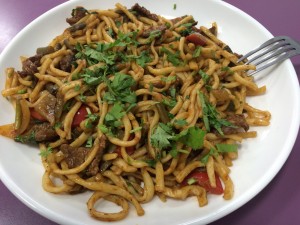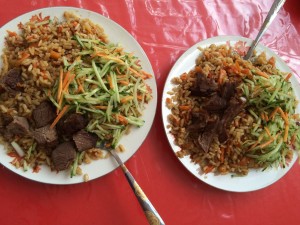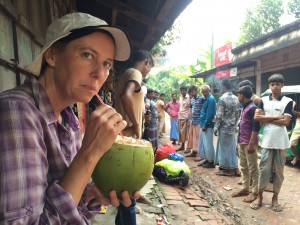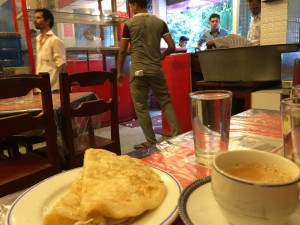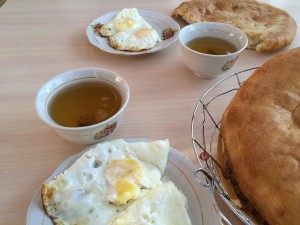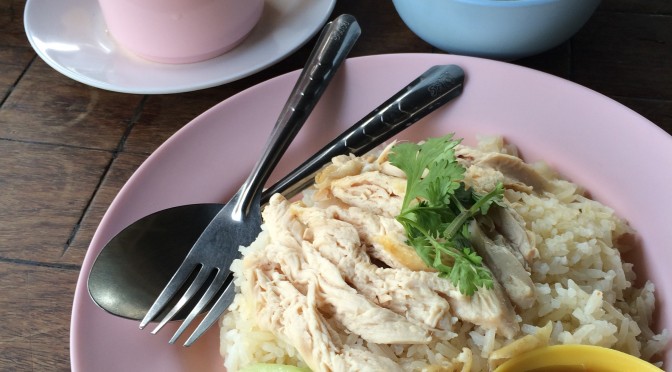Want to lose weight? Come walk with us! We’ll show you how to drop a few kilos.
During the first seven months of our walk, I lost about 5 kilos (11 pounds), and Lluís dropped 12 kilos (26.5 pounds). We started out on the heavy side, packing in lots of calories before we left, and recently spent part of our two-month break pulling ourselves back to a slightly-higher-than-normal number on the scale.
Walking 20-30 kilometers a day will do that, regardless of how much we eat. Even Lluís, who hates restaurants and eating out, made a big effort to stay well-fed and healthy. But, it’s not an easy task. We face food and water challenges every day.
So, what are we eating? The short answer is everything we can. The better answer is whatever we can digest.
Going against wise travel advice to avoid certain kinds of foods that would surely lead to upside-down stomach issues, we eat and drink almost anything that is generously offered to us. Tomatoes, cucumbers, carrots, apples, cherries, strawberries, melons, mystery meat, sauce, milk, yogurt, rice, bread, potatoes, eggs, tea, coffee, lemonade, fruit shakes, and, yes, water from unknown sources of origin. By all backpacking standards, this is absolutely and completely reckless.
We have little choice in the matter. We have to eat what is available. We are on three to five-year journey, and every day we live outside our comfort zone. Our stomachs need to be strong and adapt in the same way the rest of our bodies are adapting.
We are incredibly surprised how well we have fared so far. We do the best we can to filter our water and buy bottled water when we see it, and we attempt to steer clear of food that has been laying around for a while. Still, we are touched now and again with a bad spell. We have had varying degrees of diarrhea but it has never been rough enough to make us stop walking. We have been very lucky to date, and we are touching wood that this luck continues.
The Routine
Since every day is different, we don’t have a routine, but if we did, it would look something like this.
We have some sort of breakfast about 5 or 6 a.m., usually whatever is in our backpacks, like oatmeal, bread or cookies, a piece of fruit, a spoon of honey and, when we can, a scoop of peanut butter. Later in the morning, we’ll stop for a snack along the way at a roadside shop or accept a kind invitation to go to someone’s home. We may have a coffee, a tea, water, some fried dough-stuffed thing, a granola bar, or packaged pastry.
Lunch is usually our biggest meal, like at home. About noon or 1 p.m. when it’s too hot to move, we stop wherever we can, pick out the heartiest dish we can find, and sit for a long while, waiting for cooler hours. We lift pots lids to see what’s inside, look at pictures on menus and struggle through three or four survival food phases we memorize in each country. Sometimes, we pick fried noodles or rice with veggies and pieces of chicken, pork, beef, fish, sheep or goat meat. Other times we have soup or stew with bread and fruit. Many days, we are too exhausted to choose and go with an egg or two and whatever staple starch is behind the counter; we’ve eaten more fried eggs and rice in a few months than we have eaten in all our lives.
Dinner depends on where we sleep. On camping nights, we eat whatever we have with us–nuts, fruit and bread are fairly normal. If we are staying at guesthouse or hotel, we will go to a restaurant. If we sleep at a family’s house, they often invite us to join them during dinner, and we happily do.
Many days, however, it’s too hot and humid to eat too much. We have had many months of +30, +40 degree Celsius (90-100 degrees Fahrenheit) temperatures. On the hottest days, we’ll have mostly fruit, like papaya, coconut, apples, watermelon or rock melon. Sometimes, all we want is a bottle of ice cold water or some soda. There are only a few things more pleasurable than that first sip of cold water passing our lips as sweat drips down our foreheads into our eyes. It’s so good we call this the Water Ritual –that moment when we untwist the cap and close our eyes as the cold liquid glides down our throats. Ahhhhhhh!!!!!
The Meals
Here are some of our typical meals.
Before we we dive in with our forks, we always start with a small invocation-mantra, “Thank you to the people who prepared this food. Please don’t make us sick.”



